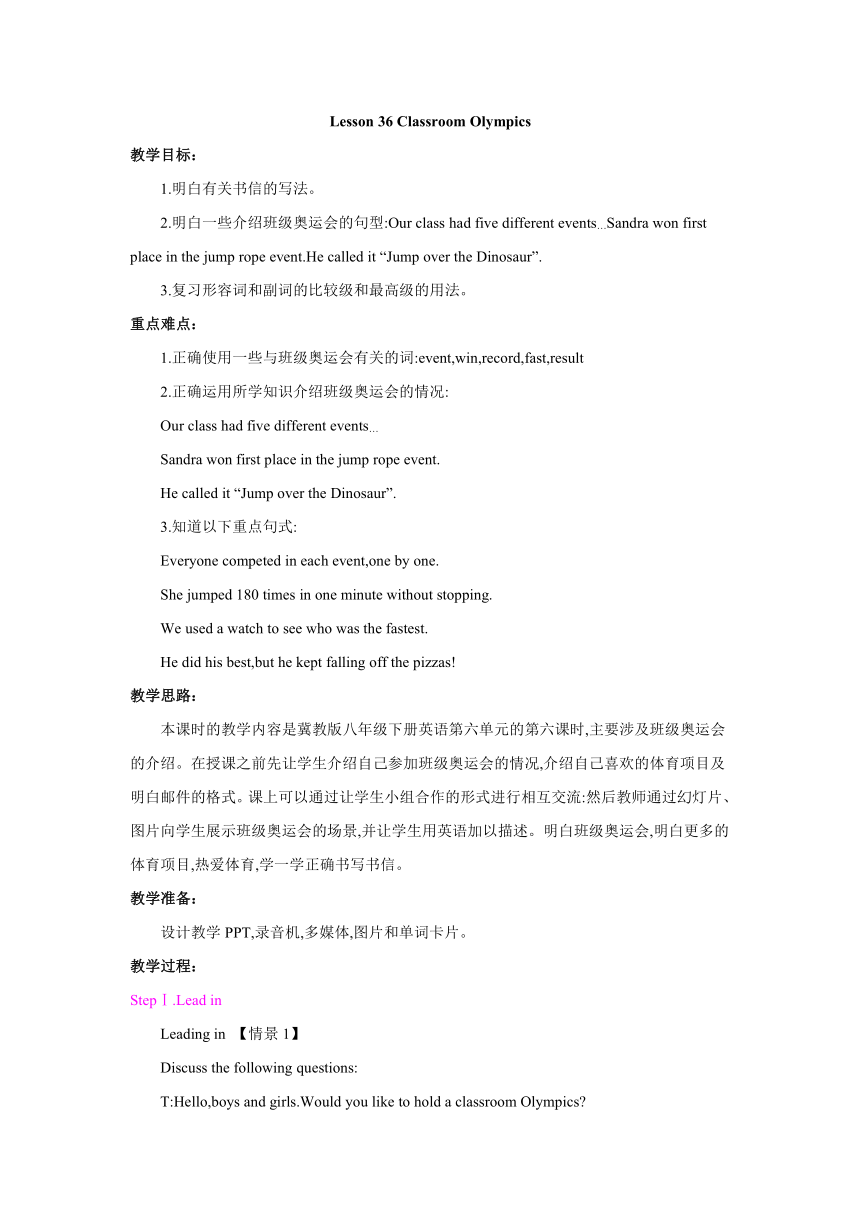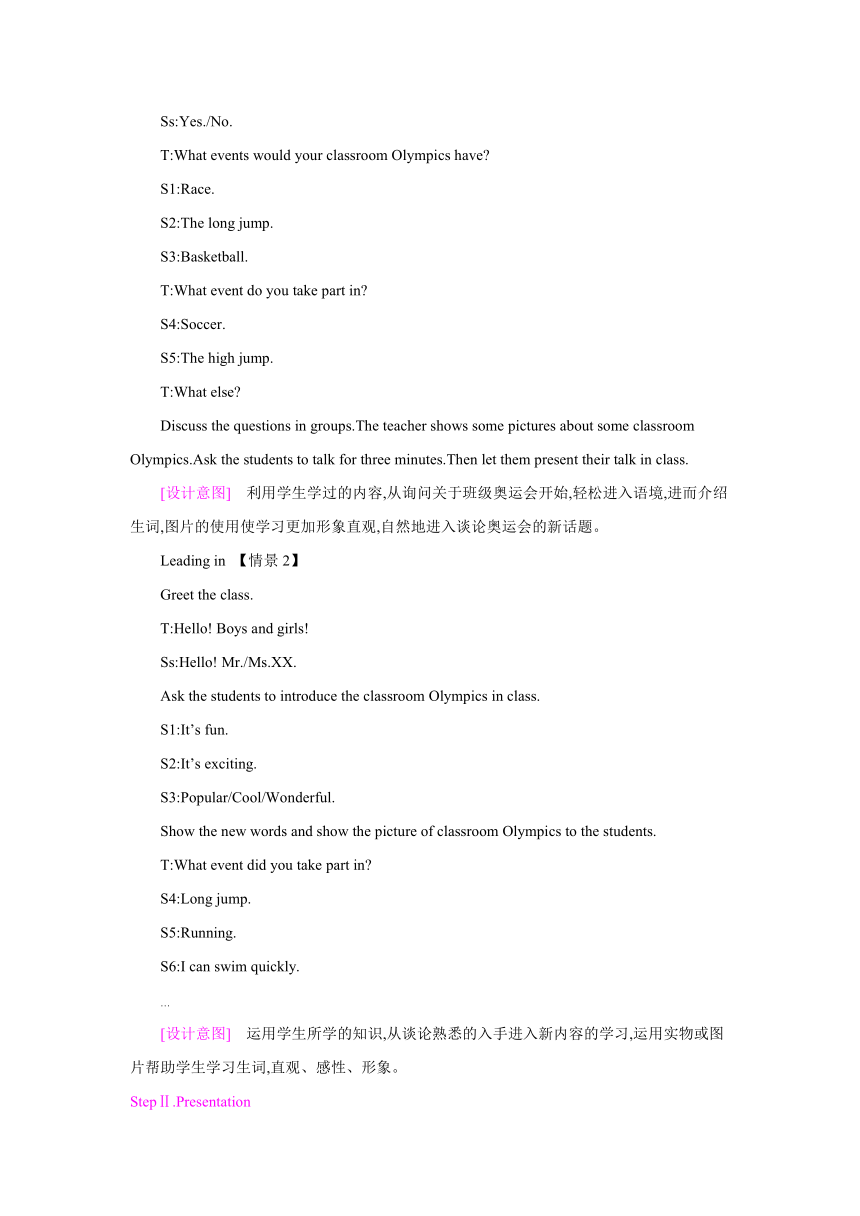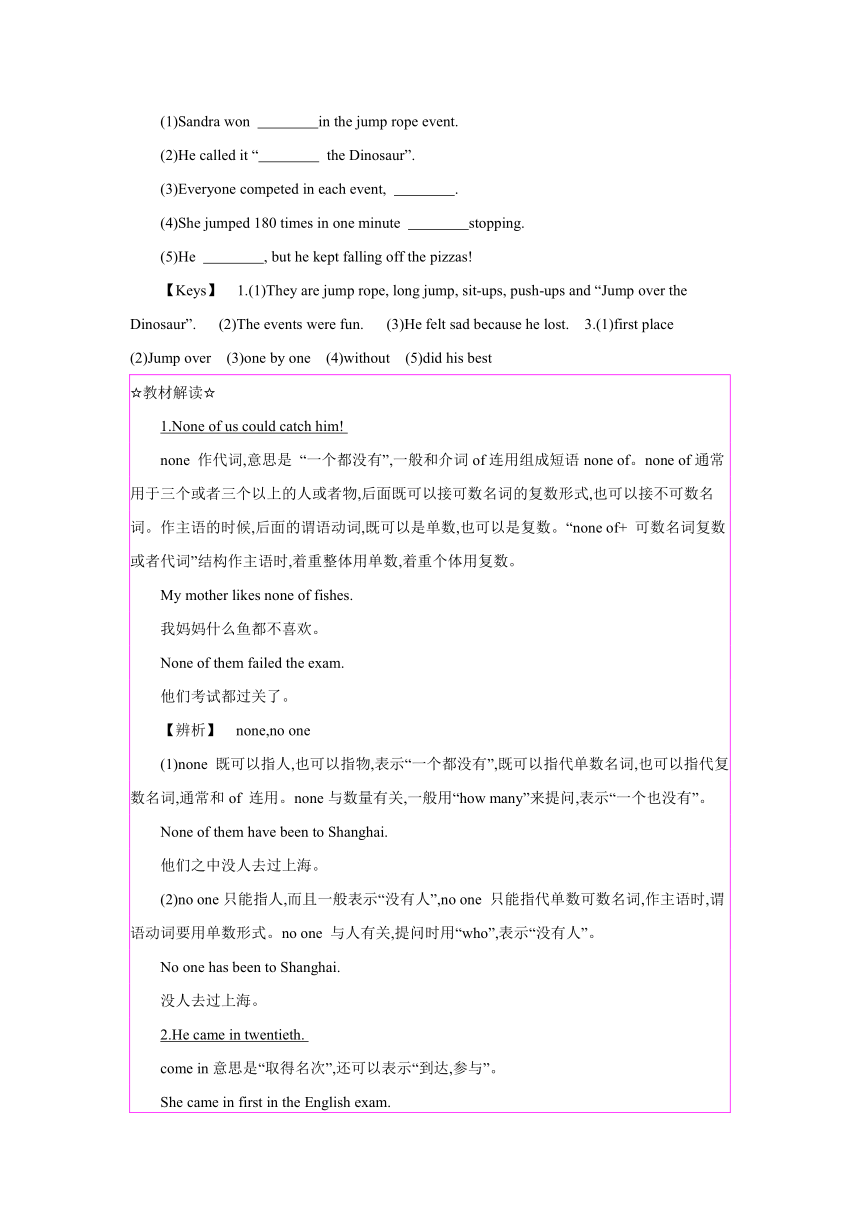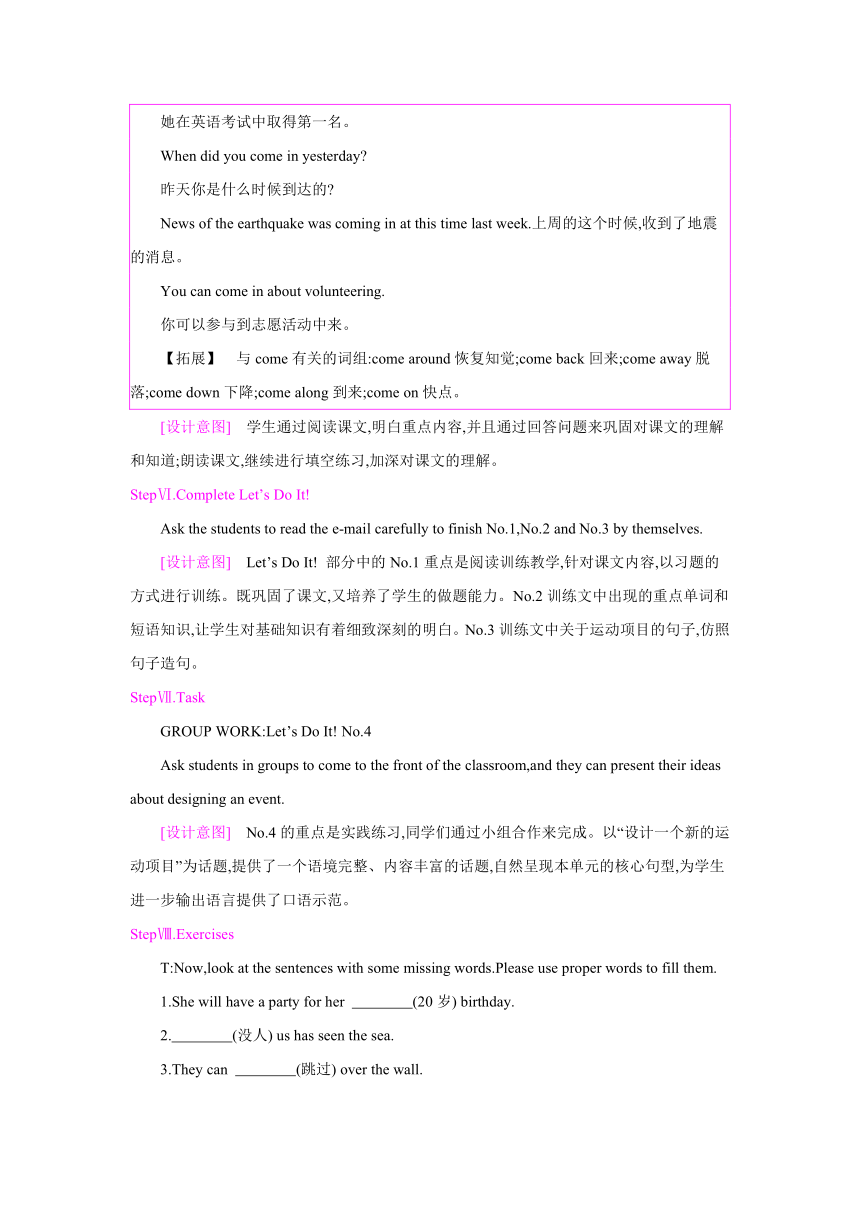Lesson 36 Classroom Olympics 教学设计
文档属性
| 名称 | Lesson 36 Classroom Olympics 教学设计 |  | |
| 格式 | zip | ||
| 文件大小 | 30.8KB | ||
| 资源类型 | 教案 | ||
| 版本资源 | 冀教版 | ||
| 科目 | 英语 | ||
| 更新时间 | 2019-06-28 14:25:44 | ||
图片预览





文档简介
Lesson 36 Classroom Olympics
教学目标:
1.明白有关书信的写法。
2.明白一些介绍班级奥运会的句型:Our class had five different events…Sandra won first place in the jump rope event.He called it “Jump over the Dinosaur”.
3.复习形容词和副词的比较级和最高级的用法。
重点难点:
1.正确使用一些与班级奥运会有关的词:event,win,record,fast,result
2.正确运用所学知识介绍班级奥运会的情况:
Our class had five different events…
Sandra won first place in the jump rope event.
He called it “Jump over the Dinosaur”.
3.知道以下重点句式:
Everyone competed in each event,one by one.
She jumped 180 times in one minute without stopping.
We used a watch to see who was the fastest.
He did his best,but he kept falling off the pizzas!
教学思路:
本课时的教学内容是冀教版八年级下册英语第六单元的第六课时,主要涉及班级奥运会的介绍。在授课之前先让学生介绍自己参加班级奥运会的情况,介绍自己喜欢的体育项目及明白邮件的格式。课上可以通过让学生小组合作的形式进行相互交流:然后教师通过幻灯片、图片向学生展示班级奥运会的场景,并让学生用英语加以描述。明白班级奥运会,明白更多的体育项目,热爱体育,学一学正确书写书信。
教学准备:
设计教学PPT,录音机,多媒体,图片和单词卡片。
教学过程:
StepⅠ.Lead in
Leading in 【情景1】
Discuss the following questions:
T:Hello,boys and girls.Would you like to hold a classroom Olympics?
Ss:Yes./No.
T:What events would your classroom Olympics have?
S1:Race.
S2:The long jump.
S3:Basketball.
T:What event do you take part in?
S4:Soccer.
S5:The high jump.
T:What else?
Discuss the questions in groups.The teacher shows some pictures about some classroom Olympics.Ask the students to talk for three minutes.Then let them present their talk in class.
[设计意图] 利用学生学过的内容,从询问关于班级奥运会开始,轻松进入语境,进而介绍生词,图片的使用使学习更加形象直观,自然地进入谈论奥运会的新话题。
Leading in 【情景2】
Greet the class.
T:Hello! Boys and girls!
Ss:Hello! Mr./Ms.XX.
Ask the students to introduce the classroom Olympics in class.
S1:It’s fun.
S2:It’s exciting.
S3:Popular/Cool/Wonderful.
Show the new words and show the picture of classroom Olympics to the students.
T:What event did you take part in?
S4:Long jump.
S5:Running.
S6:I can swim quickly.
…
[设计意图] 运用学生所学的知识,从谈论熟悉的入手进入新内容的学习,运用实物或图片帮助学生学习生词,直观、感性、形象。
StepⅡ.Presentation
If some students feel the e-mail is too long,the teacher can divide it into two or three parts.Then ask them to read them in groups.
(1)None of us could catch him!
(2)He came in twentieth.
(3)She jumped 180 times in one minute without stopping.
(4)We used a watch to see who was the fastest.
(5)He did his best,but he kept falling off the pizzas!
Please pay attention to the word:twentieth.
[设计意图] 小组合作探究进行讨论,创设情景,使同学们身临其境,激发学习的欲望。在练习中巩固本课需要知道的句型。
StepⅢ.Listening
T:Listen to the tape and answer the questions:
1.How many events do they have?
2.Who won the first place in the jump rope event?
3.What is Danny’s favourite event?
【Keys】 1.Five. 2.Sandra. 3.Jump over the Dinosaur.
[设计意图] 加深同学们对整体的知道,学生们带着问题有目的地倾听,容易把握内容回答问题。
StepⅣ.Post-listening Activities
After listening to the e-mail,get the class to read it aloud.
Then practice the e-mail.Focus on the stressed words,pronunciation and intonation.
[设计意图] 学生训练听力之后,朗读巩固,训练学生的语音语调,同时深入明白课文内容。
StepⅤ.Reading
1.Read the text and answer the following questions.
(1)What were the events of the classroom Olympics?
(2)How do they like the events?
(3)How did Brian feel?
2.Then ask some volunteers to read the passage.
3.Read the text again and fill in the blanks.
(1)Sandra won in the jump rope event.?
(2)He called it “ the Dinosaur”.?
(3)Everyone competed in each event, .?
(4)She jumped 180 times in one minute stopping.?
(5)He , but he kept falling off the pizzas!?
【Keys】 1.(1)They are jump rope, long jump, sit-ups, push-ups and “Jump over the Dinosaur”. (2)The events were fun. (3)He felt sad because he lost. 3.(1)first place (2)Jump over (3)one by one (4)without (5)did his best
☆教材解读☆
1.None of us could catch him!?
none 作代词,意思是 “一个都没有”,一般和介词of连用组成短语none of。none of通常用于三个或者三个以上的人或者物,后面既可以接可数名词的复数形式,也可以接不可数名词。作主语的时候,后面的谓语动词,既可以是单数,也可以是复数。“none of+ 可数名词复数或者代词”结构作主语时,着重整体用单数,着重个体用复数。
My mother likes none of fishes.
我妈妈什么鱼都不喜欢。
None of them failed the exam.
他们考试都过关了。
【辨析】 none,no one
(1)none 既可以指人,也可以指物,表示“一个都没有”,既可以指代单数名词,也可以指代复数名词,通常和of 连用。none与数量有关,一般用“how many”来提问,表示“一个也没有”。
None of them have been to Shanghai.
他们之中没人去过上海。
(2)no one只能指人,而且一般表示“没有人”,no one 只能指代单数可数名词,作主语时,谓语动词要用单数形式。no one 与人有关,提问时用“who”,表示“没有人”。
No one has been to Shanghai.
没人去过上海。
2.He came in twentieth.?
come in意思是“取得名次”,还可以表示“到达,参与”。
She came in first in the English exam.
她在英语考试中取得第一名。
When did you come in yesterday?
昨天你是什么时候到达的?
News of the earthquake was coming in at this time last week.上周的这个时候,收到了地震的消息。
You can come in about volunteering.
你可以参与到志愿活动中来。
【拓展】 与come有关的词组:come around恢复知觉;come back回来;come away脱落;come down下降;come along到来;come on快点。
[设计意图] 学生通过阅读课文,明白重点内容,并且通过回答问题来巩固对课文的理解和知道;朗读课文,继续进行填空练习,加深对课文的理解。
StepⅥ.Complete Let’s Do It!
Ask the students to read the e-mail carefully to finish No.1,No.2 and No.3 by themselves.
[设计意图] Let’s Do It! 部分中的No.1重点是阅读训练教学,针对课文内容,以习题的方式进行训练。既巩固了课文,又培养了学生的做题能力。No.2训练文中出现的重点单词和短语知识,让学生对基础知识有着细致深刻的明白。No.3训练文中关于运动项目的句子,仿照句子造句。
StepⅦ.Task
GROUP WORK:Let’s Do It! No.4
Ask students in groups to come to the front of the classroom,and they can present their ideas about designing an event.
[设计意图] No.4的重点是实践练习,同学们通过小组合作来完成。以“设计一个新的运动项目”为话题,提供了一个语境完整、内容丰富的话题,自然呈现本单元的核心句型,为学生进一步输出语言提供了口语示范。
StepⅧ.Exercises
T:Now,look at the sentences with some missing words.Please use proper words to fill them.
1.She will have a party for her (20岁) birthday.?
2. (没人) us has seen the sea.?
3.They can (跳过) over the wall.?
4.My father’s ride is (更慢) than my mother’s.?
5.What event did you (参加)??
【Keys】 1.twentieth 2.None of 3.jump 4.slower 5.take part in
[设计意图] 以学评教、强化落实。当堂检测主要是由本节内容组成的形成性评价,利用已知的信息,让学生补充,让他们得到充分的训练。
StepⅨ.Homework
1.Practice the e-mail with your group members after class.
2.Copy the new words twice.
[设计意图] 口头练习和单词记忆相结合,复习、归纳,注重语言知识的操练与积累。
Lesson 36 Classroom Olympics
race,twentieth,rope,none
jump over,come in
Our class had five different events…
Sandra won first place in the jump rope event.
He called it “Jump over the Dinosaur”.
Everyone competed in each event,one by one.
She jumped 180 times in one minute without stopping.
We used a watch to see who was the fastest.
He did his best,but he kept falling off the pizzas!
教材习题解答
【Lesson 36】
1 1.Five.They are jump rope,long jump,sit-ups,push-ups and “Jump over the Dinosaur”. 2.Paper pizzas,a cardboard donut and a toy dinosaur. 3.Danny. 4.Brian was sad because he lost. 5.The events were fun!
2 1.event 2.rope 3.result 4.none
【Unit Review】
Building Your Vocabulary
Ⅰ 1.Ropes 2.kilos 3.gold 4.none 5.Peace
Ⅱ race, faster, give, best, won
Grammar in Use
1.better 2.easier 3.farthest 4.worse 5.less
Putting It All Together
1.Because in many countries, the weather is too hot for sports such as skiing and skating. 2.In 1980. 3.Ye Qiaobo.
语法精讲
形容词和副词的比较等级
(一)形容词和副词的等级变化
大多数形容词和副词有三个等级:原级、比较级和最高级,以此来表示人或事物的等级差别。原级即原形,比较级和最高级的词形变化有规则与不规则两种变化。
1.规则变化
构成情况
例 词
单音节词或少数双音节词在词尾加-er或-est,分别构成比较级和最高级。
tall→ taller→ tallest
young→ younger→ youngest
以不发音的字母-e结尾的形容词和副词,只加-r构成比较级,加-st构成最高级。
late→ later→ latest
nice→ nicer→ nicest
以“辅音字母+y”结尾的词,先将y变成i,再加-er构成比较级,加-est构成最高级。
heavy→ heavier→ heaviest
busy→ busier→ busiest
以一个辅音字母结尾的重读闭音节词,双写这一辅音字母再加-er或-est。
thin→ thinner→ thinnest
hot→ hotter→ hottest
多音节或部分双音节词,在其前加more或the most。
useful→ more useful→the most useful
important→ more important→the most important
2.不规则变化
good/well→better→best
bad/badly/ill→worse→worst
many/much→more→most
little→less→least
【注意】 farther,farthest指距离“更远”和“最远”,而further,furthest指“更进一步”和“最深一层”;older,oldest 指年龄大小,用于人或物之间的比较,而elder,eldest用于表示兄弟姐妹之间的长幼关系。
(二)形容词和副词的等级用法
1.原级的用法
构成情况
例 句
“A+谓语动词+as+原级+as+B”表示“A和B一样……”。
This book is as interesting as that one.这本书和那本书一样有趣。
“A+谓语动词+not as/so+原级+as+B”表示“A不如B……”。
The weather in Beijing is not as/so hot as that in Wuhan.北京的天气不如武汉的天气热。
2.比较级的用法
用比较级进行比较,常用连词than,同时可用much,even,a little等表示比较程度的词进行修饰。
构成情况
例 句
“A+谓语动词+比较级+than+B”表示“A比B……”。
Li Ming’s apple is bigger than Wang Bin’s.李明的苹果比王宾的大。
“A+谓语动词+less+原级+than+B”表示“A不如B……”。
I think music is less important than Chinese.我认为音乐不如语文重要。
Wei Fang writes less carefully than Song Lingling.魏芳不如宋玲玲写得认真。
“A+谓语动词+比较级+than any other+单数名词”表示“A比其他任何一个人或物都……”。
Shanghai is bigger than any other city in China.上海比中国其他任何城市都大。
He studies harder than any other student in his class.他比他班上其他任何学生学习都努力。
“A+谓语动词+the+比较级+of the two+…”表示“A是两者中较……的”。
Wang Fei is the taller of the two brothers.王飞是兄弟两人中较高的那个。
“the+比较级,the+比较级”意为“越……,就越……”,表示两个过程按比例同时增减。
The busier he is,the happier he feels.他越忙越觉得高兴。
“比较级+and+比较级”或“more and more+多音节的形容词或副词”表示“越来越……”。
Our life gets better and better.我们的生活变得越来越好。
Our city is becoming more and more beautiful.我们的城市变得越来越美了。
3.最高级的用法
用最高级进行比较是对三者或三者以上的人或物进行比较,其后一般要接表示范围的in或of短语,其中形容词最高级之前要加定冠词the,副词最高级之前可以加定冠词the,也可以不加the。
构成情况
例 句
“A+谓语动词+(the+)最高级+in/of短语”表示“A在某一范围内或某类人或物中最……”。
This park is the most beautiful of the four.这个公园是这四个公园中最漂亮的。
Jack studies (the) hardest in his class.杰克在他班上学习最努力。
“A+谓语动词+one of the+最高级+复数名词+in/of短语”表示“A是……中最……的之一”。
Miss Li is one of the most popular teachers in our school.李老师是我们学校最受欢迎的老师之一。
“A+谓语动词+the+序数词+最高级+单数名词+in/of短语”表示“A是……中第……最……的……”。
The Yellow River is the second longest river in China.黄河是中国第二长河。
“特殊疑问词+谓语动词+the+最高级,A,B or C?”表示“在A、B、C中,……最……?”
Which is the biggest,the sun,the moon or the earth? 太阳、月亮和地球哪一个最大?
(三)形容词和副词的等级转换
构成情况
例 句
“not so/as+原级+as”可改为“比较级+than”。
This river is not so/as long as that one.
=This river is shorter than that one.
“not so/as+原级+as”还可改为“less+原级(多音节词)+than”。
Science is not so/as popular as art.
=Science is less popular than art.
“最高级+of/in短语”可改为“比较级+than any other+单数名词”或“比较级+than the other+复数名词”等。
He jumped farthest of all.
=He jumped farther than any other boy/the other boys.
构成情况
例 句
用反义词改写比较级句型。
There are more apples in this basket than in that one.
=There are fewer apples in that basket than in this one.
“like A better than B”可改为“prefer A to B”。
He likes English better than science.
=He prefers English to science.
“like…best(of all)”可改为“be one’s favourite”。
I like English best of all the subjects.
=English is my favourite.
其他还可根据句意改写。
The more trees we grow,the better it will be for us.
=If we grow more trees,it will be better for us.
教学目标:
1.明白有关书信的写法。
2.明白一些介绍班级奥运会的句型:Our class had five different events…Sandra won first place in the jump rope event.He called it “Jump over the Dinosaur”.
3.复习形容词和副词的比较级和最高级的用法。
重点难点:
1.正确使用一些与班级奥运会有关的词:event,win,record,fast,result
2.正确运用所学知识介绍班级奥运会的情况:
Our class had five different events…
Sandra won first place in the jump rope event.
He called it “Jump over the Dinosaur”.
3.知道以下重点句式:
Everyone competed in each event,one by one.
She jumped 180 times in one minute without stopping.
We used a watch to see who was the fastest.
He did his best,but he kept falling off the pizzas!
教学思路:
本课时的教学内容是冀教版八年级下册英语第六单元的第六课时,主要涉及班级奥运会的介绍。在授课之前先让学生介绍自己参加班级奥运会的情况,介绍自己喜欢的体育项目及明白邮件的格式。课上可以通过让学生小组合作的形式进行相互交流:然后教师通过幻灯片、图片向学生展示班级奥运会的场景,并让学生用英语加以描述。明白班级奥运会,明白更多的体育项目,热爱体育,学一学正确书写书信。
教学准备:
设计教学PPT,录音机,多媒体,图片和单词卡片。
教学过程:
StepⅠ.Lead in
Leading in 【情景1】
Discuss the following questions:
T:Hello,boys and girls.Would you like to hold a classroom Olympics?
Ss:Yes./No.
T:What events would your classroom Olympics have?
S1:Race.
S2:The long jump.
S3:Basketball.
T:What event do you take part in?
S4:Soccer.
S5:The high jump.
T:What else?
Discuss the questions in groups.The teacher shows some pictures about some classroom Olympics.Ask the students to talk for three minutes.Then let them present their talk in class.
[设计意图] 利用学生学过的内容,从询问关于班级奥运会开始,轻松进入语境,进而介绍生词,图片的使用使学习更加形象直观,自然地进入谈论奥运会的新话题。
Leading in 【情景2】
Greet the class.
T:Hello! Boys and girls!
Ss:Hello! Mr./Ms.XX.
Ask the students to introduce the classroom Olympics in class.
S1:It’s fun.
S2:It’s exciting.
S3:Popular/Cool/Wonderful.
Show the new words and show the picture of classroom Olympics to the students.
T:What event did you take part in?
S4:Long jump.
S5:Running.
S6:I can swim quickly.
…
[设计意图] 运用学生所学的知识,从谈论熟悉的入手进入新内容的学习,运用实物或图片帮助学生学习生词,直观、感性、形象。
StepⅡ.Presentation
If some students feel the e-mail is too long,the teacher can divide it into two or three parts.Then ask them to read them in groups.
(1)None of us could catch him!
(2)He came in twentieth.
(3)She jumped 180 times in one minute without stopping.
(4)We used a watch to see who was the fastest.
(5)He did his best,but he kept falling off the pizzas!
Please pay attention to the word:twentieth.
[设计意图] 小组合作探究进行讨论,创设情景,使同学们身临其境,激发学习的欲望。在练习中巩固本课需要知道的句型。
StepⅢ.Listening
T:Listen to the tape and answer the questions:
1.How many events do they have?
2.Who won the first place in the jump rope event?
3.What is Danny’s favourite event?
【Keys】 1.Five. 2.Sandra. 3.Jump over the Dinosaur.
[设计意图] 加深同学们对整体的知道,学生们带着问题有目的地倾听,容易把握内容回答问题。
StepⅣ.Post-listening Activities
After listening to the e-mail,get the class to read it aloud.
Then practice the e-mail.Focus on the stressed words,pronunciation and intonation.
[设计意图] 学生训练听力之后,朗读巩固,训练学生的语音语调,同时深入明白课文内容。
StepⅤ.Reading
1.Read the text and answer the following questions.
(1)What were the events of the classroom Olympics?
(2)How do they like the events?
(3)How did Brian feel?
2.Then ask some volunteers to read the passage.
3.Read the text again and fill in the blanks.
(1)Sandra won in the jump rope event.?
(2)He called it “ the Dinosaur”.?
(3)Everyone competed in each event, .?
(4)She jumped 180 times in one minute stopping.?
(5)He , but he kept falling off the pizzas!?
【Keys】 1.(1)They are jump rope, long jump, sit-ups, push-ups and “Jump over the Dinosaur”. (2)The events were fun. (3)He felt sad because he lost. 3.(1)first place (2)Jump over (3)one by one (4)without (5)did his best
☆教材解读☆
1.None of us could catch him!?
none 作代词,意思是 “一个都没有”,一般和介词of连用组成短语none of。none of通常用于三个或者三个以上的人或者物,后面既可以接可数名词的复数形式,也可以接不可数名词。作主语的时候,后面的谓语动词,既可以是单数,也可以是复数。“none of+ 可数名词复数或者代词”结构作主语时,着重整体用单数,着重个体用复数。
My mother likes none of fishes.
我妈妈什么鱼都不喜欢。
None of them failed the exam.
他们考试都过关了。
【辨析】 none,no one
(1)none 既可以指人,也可以指物,表示“一个都没有”,既可以指代单数名词,也可以指代复数名词,通常和of 连用。none与数量有关,一般用“how many”来提问,表示“一个也没有”。
None of them have been to Shanghai.
他们之中没人去过上海。
(2)no one只能指人,而且一般表示“没有人”,no one 只能指代单数可数名词,作主语时,谓语动词要用单数形式。no one 与人有关,提问时用“who”,表示“没有人”。
No one has been to Shanghai.
没人去过上海。
2.He came in twentieth.?
come in意思是“取得名次”,还可以表示“到达,参与”。
She came in first in the English exam.
她在英语考试中取得第一名。
When did you come in yesterday?
昨天你是什么时候到达的?
News of the earthquake was coming in at this time last week.上周的这个时候,收到了地震的消息。
You can come in about volunteering.
你可以参与到志愿活动中来。
【拓展】 与come有关的词组:come around恢复知觉;come back回来;come away脱落;come down下降;come along到来;come on快点。
[设计意图] 学生通过阅读课文,明白重点内容,并且通过回答问题来巩固对课文的理解和知道;朗读课文,继续进行填空练习,加深对课文的理解。
StepⅥ.Complete Let’s Do It!
Ask the students to read the e-mail carefully to finish No.1,No.2 and No.3 by themselves.
[设计意图] Let’s Do It! 部分中的No.1重点是阅读训练教学,针对课文内容,以习题的方式进行训练。既巩固了课文,又培养了学生的做题能力。No.2训练文中出现的重点单词和短语知识,让学生对基础知识有着细致深刻的明白。No.3训练文中关于运动项目的句子,仿照句子造句。
StepⅦ.Task
GROUP WORK:Let’s Do It! No.4
Ask students in groups to come to the front of the classroom,and they can present their ideas about designing an event.
[设计意图] No.4的重点是实践练习,同学们通过小组合作来完成。以“设计一个新的运动项目”为话题,提供了一个语境完整、内容丰富的话题,自然呈现本单元的核心句型,为学生进一步输出语言提供了口语示范。
StepⅧ.Exercises
T:Now,look at the sentences with some missing words.Please use proper words to fill them.
1.She will have a party for her (20岁) birthday.?
2. (没人) us has seen the sea.?
3.They can (跳过) over the wall.?
4.My father’s ride is (更慢) than my mother’s.?
5.What event did you (参加)??
【Keys】 1.twentieth 2.None of 3.jump 4.slower 5.take part in
[设计意图] 以学评教、强化落实。当堂检测主要是由本节内容组成的形成性评价,利用已知的信息,让学生补充,让他们得到充分的训练。
StepⅨ.Homework
1.Practice the e-mail with your group members after class.
2.Copy the new words twice.
[设计意图] 口头练习和单词记忆相结合,复习、归纳,注重语言知识的操练与积累。
Lesson 36 Classroom Olympics
race,twentieth,rope,none
jump over,come in
Our class had five different events…
Sandra won first place in the jump rope event.
He called it “Jump over the Dinosaur”.
Everyone competed in each event,one by one.
She jumped 180 times in one minute without stopping.
We used a watch to see who was the fastest.
He did his best,but he kept falling off the pizzas!
教材习题解答
【Lesson 36】
1 1.Five.They are jump rope,long jump,sit-ups,push-ups and “Jump over the Dinosaur”. 2.Paper pizzas,a cardboard donut and a toy dinosaur. 3.Danny. 4.Brian was sad because he lost. 5.The events were fun!
2 1.event 2.rope 3.result 4.none
【Unit Review】
Building Your Vocabulary
Ⅰ 1.Ropes 2.kilos 3.gold 4.none 5.Peace
Ⅱ race, faster, give, best, won
Grammar in Use
1.better 2.easier 3.farthest 4.worse 5.less
Putting It All Together
1.Because in many countries, the weather is too hot for sports such as skiing and skating. 2.In 1980. 3.Ye Qiaobo.
语法精讲
形容词和副词的比较等级
(一)形容词和副词的等级变化
大多数形容词和副词有三个等级:原级、比较级和最高级,以此来表示人或事物的等级差别。原级即原形,比较级和最高级的词形变化有规则与不规则两种变化。
1.规则变化
构成情况
例 词
单音节词或少数双音节词在词尾加-er或-est,分别构成比较级和最高级。
tall→ taller→ tallest
young→ younger→ youngest
以不发音的字母-e结尾的形容词和副词,只加-r构成比较级,加-st构成最高级。
late→ later→ latest
nice→ nicer→ nicest
以“辅音字母+y”结尾的词,先将y变成i,再加-er构成比较级,加-est构成最高级。
heavy→ heavier→ heaviest
busy→ busier→ busiest
以一个辅音字母结尾的重读闭音节词,双写这一辅音字母再加-er或-est。
thin→ thinner→ thinnest
hot→ hotter→ hottest
多音节或部分双音节词,在其前加more或the most。
useful→ more useful→the most useful
important→ more important→the most important
2.不规则变化
good/well→better→best
bad/badly/ill→worse→worst
many/much→more→most
little→less→least
【注意】 farther,farthest指距离“更远”和“最远”,而further,furthest指“更进一步”和“最深一层”;older,oldest 指年龄大小,用于人或物之间的比较,而elder,eldest用于表示兄弟姐妹之间的长幼关系。
(二)形容词和副词的等级用法
1.原级的用法
构成情况
例 句
“A+谓语动词+as+原级+as+B”表示“A和B一样……”。
This book is as interesting as that one.这本书和那本书一样有趣。
“A+谓语动词+not as/so+原级+as+B”表示“A不如B……”。
The weather in Beijing is not as/so hot as that in Wuhan.北京的天气不如武汉的天气热。
2.比较级的用法
用比较级进行比较,常用连词than,同时可用much,even,a little等表示比较程度的词进行修饰。
构成情况
例 句
“A+谓语动词+比较级+than+B”表示“A比B……”。
Li Ming’s apple is bigger than Wang Bin’s.李明的苹果比王宾的大。
“A+谓语动词+less+原级+than+B”表示“A不如B……”。
I think music is less important than Chinese.我认为音乐不如语文重要。
Wei Fang writes less carefully than Song Lingling.魏芳不如宋玲玲写得认真。
“A+谓语动词+比较级+than any other+单数名词”表示“A比其他任何一个人或物都……”。
Shanghai is bigger than any other city in China.上海比中国其他任何城市都大。
He studies harder than any other student in his class.他比他班上其他任何学生学习都努力。
“A+谓语动词+the+比较级+of the two+…”表示“A是两者中较……的”。
Wang Fei is the taller of the two brothers.王飞是兄弟两人中较高的那个。
“the+比较级,the+比较级”意为“越……,就越……”,表示两个过程按比例同时增减。
The busier he is,the happier he feels.他越忙越觉得高兴。
“比较级+and+比较级”或“more and more+多音节的形容词或副词”表示“越来越……”。
Our life gets better and better.我们的生活变得越来越好。
Our city is becoming more and more beautiful.我们的城市变得越来越美了。
3.最高级的用法
用最高级进行比较是对三者或三者以上的人或物进行比较,其后一般要接表示范围的in或of短语,其中形容词最高级之前要加定冠词the,副词最高级之前可以加定冠词the,也可以不加the。
构成情况
例 句
“A+谓语动词+(the+)最高级+in/of短语”表示“A在某一范围内或某类人或物中最……”。
This park is the most beautiful of the four.这个公园是这四个公园中最漂亮的。
Jack studies (the) hardest in his class.杰克在他班上学习最努力。
“A+谓语动词+one of the+最高级+复数名词+in/of短语”表示“A是……中最……的之一”。
Miss Li is one of the most popular teachers in our school.李老师是我们学校最受欢迎的老师之一。
“A+谓语动词+the+序数词+最高级+单数名词+in/of短语”表示“A是……中第……最……的……”。
The Yellow River is the second longest river in China.黄河是中国第二长河。
“特殊疑问词+谓语动词+the+最高级,A,B or C?”表示“在A、B、C中,……最……?”
Which is the biggest,the sun,the moon or the earth? 太阳、月亮和地球哪一个最大?
(三)形容词和副词的等级转换
构成情况
例 句
“not so/as+原级+as”可改为“比较级+than”。
This river is not so/as long as that one.
=This river is shorter than that one.
“not so/as+原级+as”还可改为“less+原级(多音节词)+than”。
Science is not so/as popular as art.
=Science is less popular than art.
“最高级+of/in短语”可改为“比较级+than any other+单数名词”或“比较级+than the other+复数名词”等。
He jumped farthest of all.
=He jumped farther than any other boy/the other boys.
构成情况
例 句
用反义词改写比较级句型。
There are more apples in this basket than in that one.
=There are fewer apples in that basket than in this one.
“like A better than B”可改为“prefer A to B”。
He likes English better than science.
=He prefers English to science.
“like…best(of all)”可改为“be one’s favourite”。
I like English best of all the subjects.
=English is my favourite.
其他还可根据句意改写。
The more trees we grow,the better it will be for us.
=If we grow more trees,it will be better for us.
同课章节目录
- Unit 1 Spring Is Coming
- Lesson 1 How's the weather?
- Lesson 2 It's Getting Warmer!
- Lesson 3 Sun Is Rising
- Lesson 4 The Spring City
- Lesson 5 Babysitting on a Spring Day
- Lesson 6 Stories about Spring
- Unit 2 Plant a Plant
- Lesson 7 Planting Trees
- Lesson 8 Why Are Plants Important?
- Lesson 9 Gardening with Mary
- Lesson 10 Make Your Garden Grow!
- Lesson 11 Amazing Plants
- Lesson 12 Danny's Plant
- Unit 3 Animals Are Our Friends
- Lesson 13 Danny's Big Scare
- Lesson 14 Amazing Animals
- Lesson 15 The Zoo Is Open
- Lesson 16 The Pear Escaped
- Lesson 17 Save the Tigers
- Lesson 18 Friendship Between Animals
- Unit 4 The Internet Connects Us
- Lesson 19 How Do You Use the Internet?
- Lesson 20 A Computer Helps!
- Lesson 21 Books or Computers?
- Lesson 22 Travel on the Internet
- Lesson 23 The Internet--Good or Bad?
- Lesson 24 An E-mail to Grandpa
- Unit 5 Buying and Selling
- Lesson 25 Raising Money
- Lesson 26 Cookies, Please!
- Lesson 27 Business English
- Lesson 28 Ms. Liu's Great Idea
- Lesson 29 How to Push a Product
- Lesson 30 A Cookie Sale
- Unit 6 Be a Champion!
- Lesson 31 Don't Fall, Danny
- Lesson 32 My Favourite Record
- Lesson 33 2800 Years of Sports
- Lesson 34 Modern Olympics
- Lesson 35 The Dream Team
- Lesson 36 Classroom Olympics
- Unit 7 Know Our World
- Lesson 37 Let's Learn Geography!
- Lesson 38 The World Is a Big Place
- Lesson 39 Ring Up or Call?
- Lesson 40 Body Language
- Lesson 41 A Class of the World
- Lesson 42 North America
- Unit 8 Save Our World
- Lesson 43 Let's Clean Up!
- Lesson 44 Environment Clubs
- Lesson 45 Let's Sort Garbage!
- Lesson 46 Protect Our Environment
- Lesson 47 Connected to Nature
- Lesson 48 Garbage Is Interesting!
